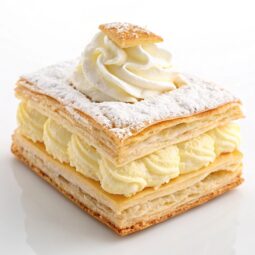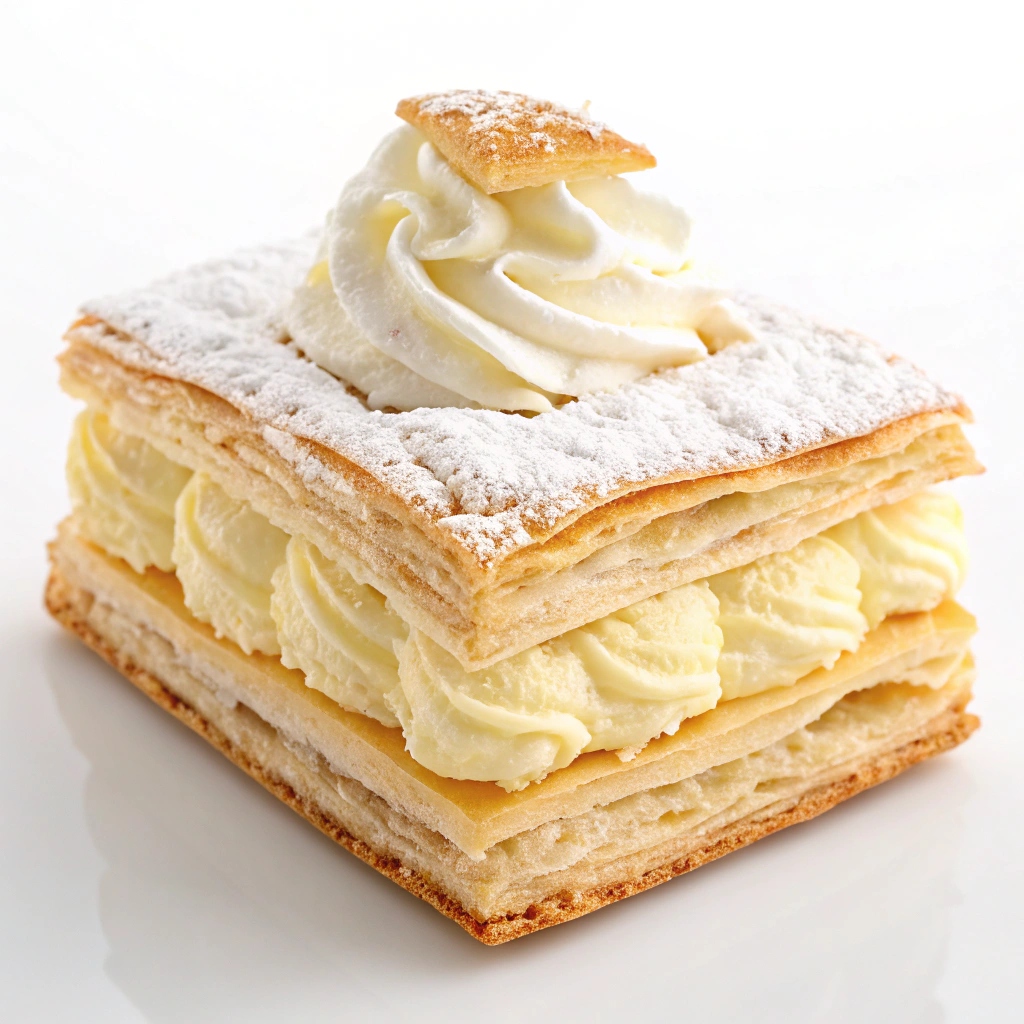There’s something magical about creating handmade puff pastry—its flaky, buttery layers are worth every moment of effort. Using the rough puff method, this recipe simplifies the process without sacrificing the delicate, golden texture that makes puff pastry so irresistible. In just three hours, you’ll craft a versatile dough perfect for sweet or savory creations, from tarts to turnovers.
Each fold of the dough builds anticipation, as the layers promise a satisfying crunch and rich, melt-in-your-mouth flavor. Whether you’re a seasoned baker or a curious beginner, this recipe invites you to experience the joy of baking from scratch. The result? A light, airy pastry that’s sure to impress and elevate any dish you dream up.
Ingredients for Handmade Puff Pastry (Rough Puff Method)

- 1 and 1/3 cups (166g) all-purpose flour (spoon & leveled, plus extra for hands, surface, and dough)
- 1 teaspoon granulated sugar
- 1/2 teaspoon salt
- 3/4 cup (1.5 sticks; 170g) unsalted butter (very cold and cubed)
- 6–8 Tablespoons (90-120ml) ice cold water
Step-by-Step Instructions
- Make the dough: In a large bowl, whisk together the flour, sugar, and salt. Add the cold, cubed butter on top. Gently toss the flour and butter with your hands, then briefly rub the butter into the flour to combine. Do not overwork the butter; it should remain in large chunks.
- Add water: Gradually add ice cold water, 1 Tablespoon (15ml) at a time, tossing the mixture with your hands after each addition. Start with 2 Tablespoons (30ml) before tossing. After about 4 Tablespoons (60ml), lightly squeeze the dough to bring it together. The dough will be shaggy but should form a clump. If sticky before 6 Tablespoons, the butter may have been too warm.
- Shape the dough: Transfer the dough to a lightly floured surface. Pat it into a 3/4 – 1 inch thick rectangle (about 5×8 inches). Fold it into thirds like a business letter, smoothing any cracks. Wrap tightly in plastic wrap, parchment, or foil, or place in a sealed container.
- 1st refrigeration: Refrigerate the dough for at least 2 hours and up to 24 hours.
- Roll & Fold: Remove the dough from the fridge. If chilled for over 3 hours, let it rest for 5 minutes. Lightly flour a work surface. Flatten the dough into a small square, then roll it into a 6×12 inch rectangle, 1/2 inch thick. Fold into thirds again. Repeat rolling and folding 4 more times for a total of 6 times.
- 2nd refrigeration: Wrap or seal the dough tightly and refrigerate for at least 15 minutes or up to 24 hours before use. You can also freeze the dough at this stage.
- Bake (optional): To bake plain, roll the dough into a 10×16 inch rectangle. Place on a lined baking sheet, brush with egg wash (1 egg + 1 Tbsp milk), and bake at 400°F (204°C) for 25-28 minutes, until golden brown and puffy.
Perfect Pairings: Sauce and Topping Ideas
Elevate your handmade puff pastry by pairing it with sweet or savory accompaniments. For a sweet treat, drizzle with vanilla glaze (1 cup powdered sugar + 2 Tbsp milk + 1 tsp vanilla extract) or top with fresh berries and whipped cream. For savory options, try a dollop of garlic herb butter or a sprinkle of grated Parmesan cheese before baking.
Storage and Reheating Tips
Store unused puff pastry dough tightly wrapped in plastic wrap or an airtight container in the refrigerator for up to 2 days. For longer storage, freeze it for up to 3 months. To reheat baked pastry, pop it in a 350°F (175°C) oven for 5-7 minutes to restore its crispiness.
Time-Saving Hacks for Busy Bakers
If you’re short on time, prepare the dough the night before and let it chill overnight. You can also double the recipe and freeze half for future use. When rolling, work quickly to keep the butter cold, and use a lightly floured surface to prevent sticking without overworking the dough.
Essential Equipment Guidance
While this recipe relies on simple tools, a heavy rolling pin and a pastry brush are must-haves for even rolling and applying egg wash. Keep a bench scraper handy to lift and fold the dough without tearing it. A rimmed baking sheet lined with parchment paper ensures even baking.
Common Questions Answered
Why is my dough sticky?
This usually happens if the butter is too warm. Chill the dough for 15-20 minutes before continuing.
Can I use salted butter?
Yes, but reduce the added salt by half.
How do I know when it’s done baking?
Look for a golden brown color and a puffy, flaky texture.

Handmade Puff Pastry Recipe
Ingredients
- 1 and 1/3 cups all-purpose flour (spoon & leveled), plus more for generously flouring hands, surface, and dough
- 1 teaspoon granulated sugar
- 1/2 teaspoon salt
- 3/4 cup unsalted butter (1.5 sticks; 170g), very cold and cubed
- 6–8 Tablespoons ice cold water (90-120ml)
Instructions
- Make the dough: Whisk the flour, sugar, and salt together in a large bowl. Place the cold and cubed butter on top. Gently toss the flour and butter together with your hands, and then briefly rub the butter into the flour to begin combining them, as you can see in the video tutorial above. You do not want to break down the butter too much in this step. This step is only possible if the butter is very cold because if the butter is warm, you’ll end up with paste. I do not recommend a food processor, pastry cutter, or mixer for this step because it will break down the butter too much.
- At this point, the butter is still in large cubes/chunks. Begin adding the ice cold water 1 Tablespoon (15ml) at a time until dough forms 1 large shaggy clump in your bowl. Use your hands to toss the mixture together after you add each Tablespoon. (I usually start with 2 Tablespoons (30ml) of water before I begin tossing together.) You can use a spatula or spoon for tossing, but I really do recommend your hands so you get a good feel of the dough. As the dough begins to hydrate after about 4 Tablespoons (60ml) of water, you can start lightly squeezing or clumping the dough together with your hands to help bring it together. Mixture will still be very shaggy, as you can see in the video above and photos below. If your dough feels sticky and wet before adding 6 Tablespoons of water, your butter was likely too warm– you can continue with the recipe, but the dough will not be as flaky.
- Pour the shaggy clump of dough out onto a lightly floured work surface. There will still be large chunks of butter at this point and that’s a good thing. Begin patting the dough down with lightly floured hands until it’s 3/4 – 1 inch thick, about a 5×8 inch rectangle. Fold the dough into thirds as if you were folding a business letter. Use your hands to gently flatten and smooth out any cracks in your dough. Wrap it up tightly in plastic wrap, parchment paper, or aluminum foil, or place into any tightly sealed container.
- 1st refrigeration: Refrigerate dough for at least 2 hours and up to 24 hours.
- Roll & Fold: Take the dough out of the refrigerator to begin the “rolling and folding” process. If the dough chilled for longer than about 3 hours, it’s likely very stiff so let it rest for about 5 minutes before you begin rolling. Lightly flour a work surface. The dough gets sticky, so make sure you have more flour nearby as you roll and fold. Use your hands to gently flatten the dough into a small square. Using a rolling pin, roll the dough into a 6 inch wide and 12 inch tall rectangle that’s 1/2 inch thick. The exact dimensions are not important, but the thickness is. As you roll, it’s best to flip the dough over once or twice to make sure it’s not sticking to your work surface. Lightly flour your work surface as needed. Fold the rectangle into thirds as if it were a business letter. (See photos and video tutorial.) Turn it clockwise or counter clockwise and roll it out into a 6×12 inch 1/2 inch thick rectangle again. Then, fold into thirds again. Turn it clockwise or counter clockwise. You’ll repeat rolling and folding 4 more times for a total of 6 times.
- 2nd Refrigeration: Wrap up/seal tightly and refrigerate for at least 15 minutes and up to 24 hours before using in your recipe. You can also freeze the dough at this point. See freezing instructions.
- Use wherever you would use frozen store-bought puff pastry. To bake plain, roll pastry dough into a 10×16-inch rectangle and place on a lined baking sheet. Brush all over with egg wash (1 large egg whisked with 1 Tbsp milk), and bake at 400°F (204°C) until golden brown and puffy, about 25-28 minutes.

